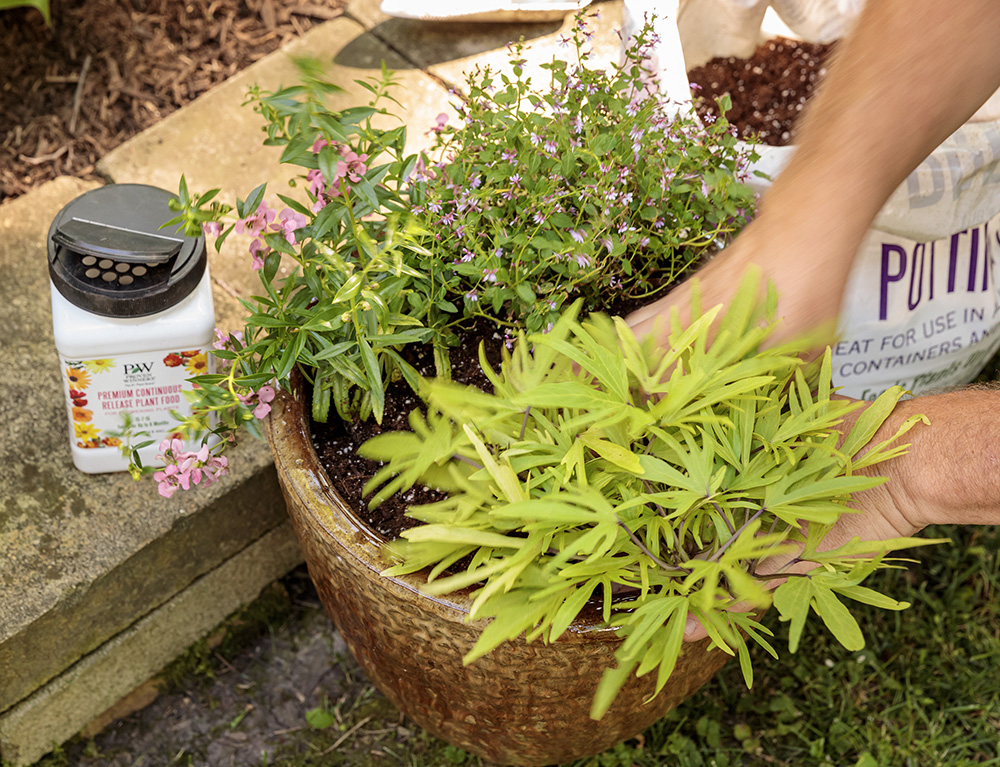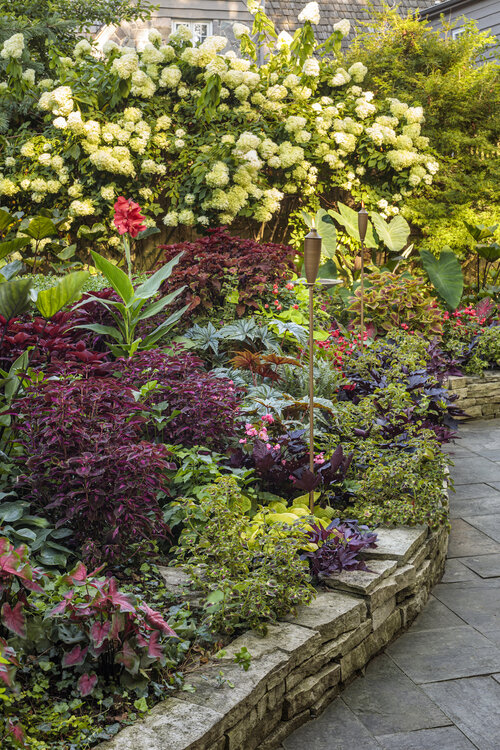How Does Your Garden Grow?
Learn how to maximize the potential of your garden plantings with tips on everying from bed prep to design to maintenance.

Most of us probably remember this popular nursery rhyme; Mary, Mary quite contrary, how does your garden grow? While we aren't likely to be growing silver bells, cockleshells and pretty maids all in a row, we are interested in how our gardens grow. Gardening tends to be a skill that is learned best by doing. This isn't to say that reading isn't a great way to learn about gardening, but going out and applying what you've read to your own garden is the only way to learn what works best for you. Each and every garden is unique and it will take time to learn the ins and outs and secrets of your own little plot of land. Remember, don't consider a dead plant a failure, look at it as a learning experience. I am currently having a learning experience or three of my own! Every great gardener has killed his or her fair share of plants.
As different as each garden is, there are topics that will need to be addressed in every garden. Below are some tips on the main areas that need to be addressed to garden successfully. This article will deal with in-ground plantings, for container garden specific tips and tricks, click here.

Soil:
The base for any garden is the soil. Good soil makes gardening MUCH easier. Unfortunately, good soil can be frustratingly difficult to find. If you've tried to garden and have had little luck, the most likely issue is your soil. Undisturbed soil is composed of several layers. The top layer is topsoil (tricky name, I know) and under that is subsoil. Topsoil is the best soil and is what plants grow in. Subsoil isn't nearly as good for growing plants. Often when a home is constructed the builder pays no attention to topsoil versus subsoil. Thus the soil at the surface of your yard and garden is just as likely to be subsoil as it is to be topsoil. Subsoil is difficult to grow plants in, if you don't improve it. If you have tried and failed to garden, don't blame a black thumb, take a closer look at your soil conditions.
Getting into the nitty gritty details of soil can be really intimidating for many gardeners. However, understanding a few basics will really improve your ability to garden effectively. Soil is composed of rock, gravel, sand, clay and organic matter. How these components combine to create your specific soil will tell you a lot about your garden. A soil test, which can be conducted by your county cooperative extension agent, is a great way to get basic information on your soil and recommendations to improve it.
Soil will fall into a few major categories; sand, clay, silt and loam are the four big ones. If you have silt or loam soil, you are sitting pretty. If you have sand or clay soils, then you may want to improve your soil prior to planting. If you learn nothing else about improving soil, know that adding organic matter, such as compost, will improve ANY soil. Understanding and improving your soil, may be the best thing you can do for your garden.
Compost:
Organic matter is a critical component of any soil for growing plants, because it improves drainage and adds nutrients to your soil. Compost is a great way to add organic matter. There are several ways to get compost for your garden. You can buy bagged compost at a garden center, but I would first check with your local municipality to see if they have compost available. This material can be very low cost or even free and is usually available in bulk rather than bagged. However, better than buying compost is creating your own. Don't worry; compost is one of those things that sounds harder than it actually is. Compost is simply plant material breaking down over time to create a soil-like substance and truthfully, compost happens by letting Mother Nature do her job. You can make it happen faster by mixing together different types of plant matter and kitchen waste (brown and green) in specific ratios, but if you leave a pile of plants lie long enough it will become compost. We have an article that covers the basics of creating your own compost (the lazy way of composting) and another one that goes into more details on the process (the fast way to get compost).

Garden Design:
When designing your garden it is good to know a few basic design principles. There are two basic types of garden beds, island beds and borders. Island beds are garden spaces that you can walk completely around and have an anchor in the middle of the bed. The anchor can be a shrub, tree, large perennial, fountain or garden statuary. Island beds are meant to be viewed from all angles. Borders are viewed from one side and are anchored by a backdrop such as a wall, fence or hedgerow.
There are also two styles of gardens, formal and informal. Geometric shapes and limited, controlled plant palettes charactherize formal gardens. Informal gardens, tend to have free flowing shapes, utilize more colors and with less rigid planting concepts. This article covers both garden types and styles.
Color is one of the most important considerations when it comes to your garden. The most crucial aspect of color is that YOU like it. However, it can be helpful to understand some color basics.

Bed Preparation:
After you've considered your soil and basic garden design, it is time to create your garden beds. If you are starting from scratch, you first need to create the outline of your bed. Using a garden hose is a great way to see how your bed will be shaped and it allows you to tweak the layout until you have the right size and shape. After determining the shape of the bed, you need to kill the existing vegetation, turn the soil over, add compost, and then top dress with more compost or mulch. This article explains this topic further.
Rather than starting from scratch, you may be planting an existing garden bed. If that bed has no existing plants, then the first step is to top dress with compost and then turn it into the soil before planting. Once again, you will want to top dress with more compost or mulch to preserve moisture and prevent weeds.
You also might be planting an existing bed that includes perennials or shrubs. These beds are a bit trickier than the previous types. You do still want to add organic matter if possible. Put a couple of inches of compost around existing plants, being careful to keep the compost from getting up against the stems of the plants as this can cause issues. If possible, work the compost into the top layer of soil, but not so deeply that you harm the roots of the plants. You can also leave the compost sitting on top of the soil. Over time, it will still add nutrients and will be naturally incorporated into your soil. Any areas without existing plants, add compost into the soil as before.
Another option for gardeners are raised beds, which can improve drainage and make garden chores less taxing.

Planting:
Once the bed is ready for plants, I usually start by placing each plant, while in it's pot, in the right place in the bed. This allows me to see if I like the arrangement and to make changes, if needed. I then dig holes for each container, trying to make the hole twice as large as the pot to encourage good root growth. Add a bit of water in the bottom of the hole, place the plant in the hole, then fill in around the plant with the loose soil, tapping it lightly to settle it around the plant. If possible, use some of the garden soil to cover the top of the root ball of the plant. This will help keep the plants from drying out too quickly. As I am planting, I often give each a light trim, to encourage branching. This isn't necessary, but often results in even better growth. After initial planting, extra care should be taken for a bit, while the plants get established. For more in-depth information on planting and caring for newly planted items, click here.

Watering:
Watering is one of the keys to keeping plants looking good long term. When it comes to watering landscapes the basic thing to remember is that it is better to water deeply less often; than it is to water a little bit more often. Deep watering encourages deep root growth, which means that you will have to water less often. In general, garden beds need about an inch of water each week. This article will cover how much and when to water in further detail. There are also many different options when it comes to dispensing water. Learn more about your irrigation options here.
 Fertilizing:
Fertilizing:
We have already touched briefly on fertilizing when we covered compost. However, there are certainly other ways to deliver nutrition to your plants. In general, we suggest using a well-balanced fertilizer in both your garden and containers. While it may be enticing to choose a "bloom booster" fertilizer, we firmly believe that if you take care of the plant, then the blooms will follow. A well-balanced fertilizer will not only provide what the plant needs, but what is needed for great blooming. For suggestions on which fertilizer to use and what to look for in a good fertilizer; click here. If your garden has a tendency to fade as the summer progresses, regular fertilization can be just the thing to boost energy and keep the plants looking their best.
Other Garden Maintenance:
One of the guiding principles when Proven Winners® is choosing plants is that they will perform all summer while being easy-to-grow. To that end, almost all of our annuals will bloom all summer without deadheading. We know you, like us, are most likely time starved and you would probably prefer that what little time you have for your garden is spent enjoying it, rather than performing chores. However, most perennials and some shrubs will still bloom more if deadheaded.

As the summer goes on, annuals will sometimes begin to look leggy or open. In most cases, when this happens the best thing to do is to give the plants a trim. Using a sharp pair of scissors or pruning shears, cut off up to 1/3 of the plant. I realize that this will likely mean that you are removing all of the blooms. It is often best to sacrifice the blooms for a week or two, to get more blooms the rest of the season. Trimming will encourage additional branching and additional branching will equal more flowers. After trimming back plants, I will usually give them an application of water soluble fertilizer to give them an energy boost, which helps jumpstart new growth.
Sometimes plants will go out of flower and you won't know why. When this happens the cause is most likely soil, light, water, temperature, nutrition or a combination of two or more of these factors, although, insects can also affect blooming. For more complete information on why plants go out of flower and, more importantly, how to get them back into flower click here.
A beautiful garden is wonderful thing, but even a gorgeous garden isn't perfect. Remember whatever issues you had this year (and there are bound to be issues), there's always next season to try again. I think that hope for next season is one of the things that makes gardening such a wonderful activity. Here's to a great garden season!




 Fertilizing:
Fertilizing:
